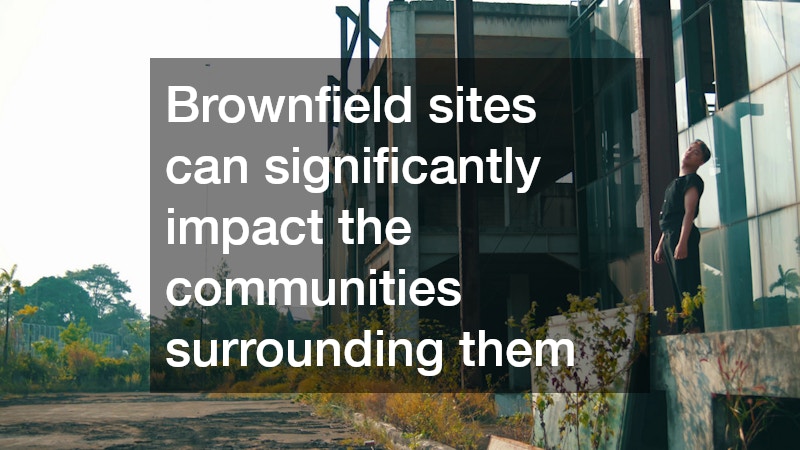
Brownfield sites refer to areas of land that were previously used for industrial or commercial purposes but are now abandoned or underutilized. These sites might have been contaminated with hazardous waste or pollutants, requiring thorough cleanup before any redevelopment can take place. Despite the challenges posed by their condition, brownfield sites represent an opportunity for urban renewal and community revitalization.
The concept of brownfield sites can be traced back to the industrial era when factories and manufacturing plants occupied vast plots of land. As these industries moved or closed, the land often remained unused due to contamination issues.
This has led to thousands of hectares of potentially valuable land lying dormant, especially in urban areas.
Identifying and cataloging these sites is a critical first step in addressing the environmental and economic concerns they pose. Governments and municipalities often maintain brownfield registries to track such sites, noting their size, location, and the specific contaminants present. This information is crucial for planning the remediation and future use of these lands.
The Impacts of Brownfield Sites
Brownfield sites can significantly impact the communities surrounding them, both negatively and positively. On the downside, the presence of contaminants can pose health risks to nearby residents, creating environmental hazards that require careful management. Additionally, these sites can drag down the aesthetic appeal of a neighborhood, leading to decreased property values and hindering economic development.
However, when properly addressed, brownfield sites can become valuable assets. By redeveloping these former industrial areas, cities can alleviate urban sprawl by utilizing existing infrastructure rather than expanding into undeveloped land. This not only preserves green spaces but also rejuvenates neighborhoods, often bringing in new businesses and housing opportunities.
The cleanup and redevelopment of brownfield sites can create jobs and stimulate local economies. Construction of new facilities provides employment opportunities, while the development of commercial and residential spaces attracts businesses and new residents. As a result, communities can experience a ripple effect of improvement, benefiting local schools, businesses, and public services.
Challenges in Redeveloping Brownfield Sites
Despite the potential benefits, redeveloping brownfield sites comes with its unique challenges. One of the primary hurdles is the high cost of environmental remediation, which involves assessing and removing contaminants before construction can begin. This process can be expensive, deterring potential developers from investing in these sites.
Additionally, there are regulatory challenges to consider when dealing with brownfield sites. Developers must navigate a maze of local, state, and federal regulations aimed at ensuring that any redevelopment is safe for future occupants and the surrounding community. This often involves comprehensive environmental assessments and lengthy approval processes.
The uncertainty of contamination levels can also affect the redevelopment timeline. Unexpected discoveries may delay projects, increase costs, or alter intended land uses. Planning for such variability requires flexibility and cooperation among developers, government entities, and the community to achieve successful outcomes.
Successful Brownfield Redevelopment Projects
Around the world, numerous successful redevelopment projects have transformed brownfield sites into thriving community spaces. A prime example can be seen in New York’s High Line, where an abandoned railway line was turned into an elevated public park, attracting millions of visitors each year. This has revitalized the surrounding neighborhood, boosting local businesses and increasing property values.
In Toronto, the Distillery District represents a successful brownfield redevelopment. What was once a derelict industrial area has been converted into a vibrant arts, culture, and entertainment zone. This transformation has drawn tourists and locals alike, making it one of the city’s top destinations and demonstrating the potential for brownfield sites to become community cornerstones.
Such projects demonstrate that with vision, investment, and collaboration, brownfield sites can be successfully repurposed to benefit communities. These redeveloped sites not only address environmental concerns but also provide new opportunities for growth and development. They serve as models of how urban areas can reclaim and repurpose past industrial lands for the betterment of society.
Future Prospects for Brownfield Sites
The future of brownfield sites looks promising as cities continue to recognize the value of redevelopment. With increasing urbanization and the need for sustainable growth, these sites offer a unique opportunity to utilize existing land efficiently and effectively. Governments and private entities are investing more in brownfield remediation, recognizing the long-term benefits of such projects.
Additionally, technological advancements in environmental remediation are making it easier and more cost-effective to clean up contaminated lands. Innovative methods, such as bioremediation and phytoremediation, are being employed to address ground contamination, offering greener and more sustainable solutions. These advancements hold the promise of transforming the way brownfield sites are approached and developed.
As awareness and support for brownfield redevelopment continue to grow, communities are becoming more engaged in these projects. Public-private partnerships often play a critical role in successful redevelopments, combining resources and expertise to overcome financial and technical challenges. With cooperation and a shared vision, brownfield sites can become catalysts for sustainable urban growth and renewal.

